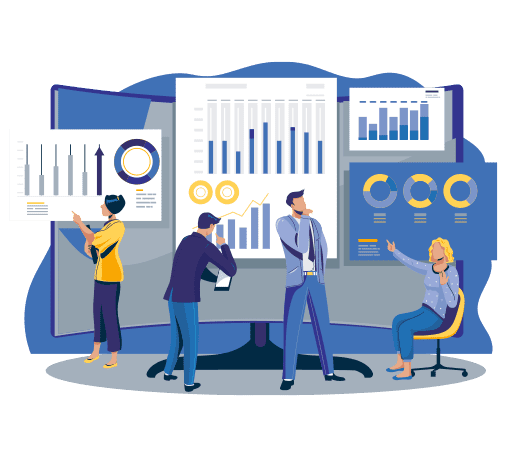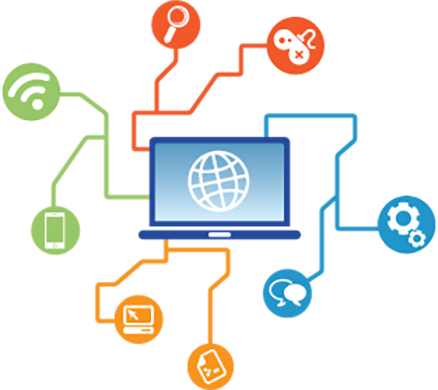
What We Do In Data Analytics
Data is crucial in today's business world. It makes all the difference in your business operations and growth. So, our key objective is to help startups and organizations to streamline operations in a digital world. Our data analysts prepare you for a data-led transformation that brings your best foot forward in the market. An inspired approach can drastically change your impact on business.
End-To-End Data Analytics Services
Growth of OneClick IT Consultancy
- 12+Years of Experience
- 1000+Project Deployment
- 200+Expert Developers
- Active Clients50+
- 30+Frameworks
Are You Looking For A Trusted Data Analytics Company?
How We Help Businesses Grow With Data Analytics Solutions & Services

With our gamut of offerings, businesses can make more effective yet prompt decisions. They can eliminate guesswork from developing marketing plans, and determine specific data to make it work more efficiently.
- Our offerings improve decision-making and help have more compelling marketing strategies. These are two potential benefits of data analytics.
- Data analytics can help businesses know their customers better, helping them market their products more effectively.
- Data analytics solutions enhance customer service and increase operational efficiency.
- It helps businesses streamline their operations, deliver resources, and augment the bottom line by allowing businesses to personalize customer experience to their needs.
Excited To Harness The Power Of Data Analytics?
How Does Data Analytics Software Work
Step 01
While conducting the data analytics process, data is collected, organized, and cleaned. First, decide the data requirements, or how the data is grouped.
Step 02
Data values may be numerical or divided by different categories. Analytics can be done through computers, online sources, cameras, environmental sources, and personnel.
Step 03
Once the data is gathered, it should be organized for an accurate analysis. It can be placed on software or a spreadsheet that can take statists.
Step 04
Once, the data is cleaned up, it should be scrubbed and checked. It ensures there is no duplicate data or error or incomplete data.
Step 05
The last step is to correct the errors before it goes on to a data analyst.
Our Data & Analytics Solutions Served Globally
- Marketing analytics
- Financial analytics
- Operational analytics
- Customer analytics
- eCommerce analytics
- Performance analytics
- Asset analytics
- Industrial analytics
We Are Experts In Data Analytics












A Few Questions Can Make A Big Difference. We Are Ready To Answer Them All.

Why Choose OneClick For Data Analytics & Engineering Solutions
- Our team is detail-oriented and keeps a close watch on deadlines, budgets, and schedules.
- We provide research-based recommendations based on detailed knowledge of the client's business, competitors, goals, and target market.
- We hire only qualified, experienced data engineers and analysts.
- Our company offers competitive and fair pricing models, as well as no surprise bills. Any unexpected or additional expenses must be pre-approved by you.
- We have worked with renowned brands and companies for many years.
- Our team believes in a proactive approach to solving problems even if they are complex in nature
FAQs Data Analytics & Engineering
The scalability is the main difference. Data analysis is the examination of data, whereas data analytics is about collecting, organizing, and storing data. Data analytics also include tools and strategies used to analyze data.
Descriptive analytics: It helps users with essential data insight into questions asked. This technique requires relevant data collection, processing, analysis, and visualization.
Diagnostic analytics: It is an advanced form of descriptive analytics that seeks to find the root cause of unexpected events. Users can take the data from descriptive analytics and explore more to find the cause.
Predictive analytics: It is a science of modeling, which uses historical data to accurately predict future events. The data sets are analyzed and a model is constructed to predict future outcomes.
Prescriptive analytics: Prescriptive Analytics can also be used by companies to create real-time recommendations on how to optimize their most important business decisions. For example, a company may use Prescriptive Analytics to determine the optimum inventory level given their current sales volume and product demands.
Data analytics is a constant process that helps businesses function regularly in a streamlined way. Once a data analytics solution is executed, it becomes easy to understand overall business analytics and solve challenges instantly. Businesses can proactively make informed decisions based on reports generated by data analytics. Thus, there is no special time to implement data analytics solutions.
We will analyze your business requirements, gain knowledge about possible objectives, and study various use cases and business goals. Thereafter we will connect the dots in your data. After assessing the data source, we will classify them to implement a quality evaluation of data. We will identify whether your data is accurate or consistent or not. Accordingly, we will generate reports and provide guidance on tools - KPIs - metrics to create a final analytics report. Up next, we start data modeling by using data from various sources. We will link them and create data models for reporting. And lastly, we provide technical support with relevant technology implementation, platforms to use, and much more.











